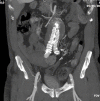Advents in the Diagnosis and Management of Ischemic Colitis
- PMID: 28929100
- PMCID: PMC5591371
- DOI: 10.3389/fsurg.2017.00047
Advents in the Diagnosis and Management of Ischemic Colitis
Abstract
Background: Ischemic colitis (IC) is a common type of ischemic insult, resulting from decreased arterial blood flow to the colon. This disease can be caused from either atherosclerotic occlusive vascular disease or non-occlusive disease. The aim of this study is to present the diagnostic methodology and management of this severe disease based on current literature.
Methods: A literature search has been done including articles referring to modern diagnosis and management of IC.
Results: IC is usually a transient disease, but it can also cause gangrene of the colon, requiring emergency surgical exploration. Diagnosis is troublesome and is based on imaging examinations, mainly computerized tomography, which in association with colonoscopy can delineate the distribution pattern and severity of disease.
Conclusion: The majority of patients with mild disease have usually complete clinical recovery within a short period. The severe forms of the disease carry high morbidity and mortality rates and prompt surgical intervention is the only way to improve the associated severe prognosis.
Keywords: colon; ischemia; necrosis; perforation; sepsis.
Figures




Similar articles
-
Ischemic diseases of the large intestine.Pathobiol Annu. 1979;9:303-37. Pathobiol Annu. 1979. PMID: 384338 Review.
-
[Colonic necrosis and stricture due to non-occlusive ischemic colitis. Report of two cases and review of the literature].Cir Cir. 2014 Jul-Aug;82(4):442-7. Cir Cir. 2014. PMID: 25167357 Review. Spanish.
-
Management of ischemic colitis.Clin Colon Rectal Surg. 2012 Dec;25(4):228-35. doi: 10.1055/s-0032-1329534. Clin Colon Rectal Surg. 2012. PMID: 24294125 Free PMC article. Review.
-
Ischemic diseases of the large intestine.Int Surg. 1981 Apr-Jun;66(2):103-17. Int Surg. 1981. PMID: 7275505
-
Ischemic colitis: the ABCs of diagnosis and surgical management.J Visc Surg. 2013 Feb;150(1):19-28. doi: 10.1016/j.jviscsurg.2013.01.002. Epub 2013 Feb 20. J Visc Surg. 2013. PMID: 23433833 Review.
Cited by
-
Diagnostic methods and drug therapies in patients with ischemic colitis.Int J Colorectal Dis. 2021 Jan;36(1):47-56. doi: 10.1007/s00384-020-03739-z. Epub 2020 Sep 16. Int J Colorectal Dis. 2021. PMID: 32936393 Free PMC article. Review.
-
Effect of hypertension on clinical outcomes in ischemic colitis.Ann Med. 2025 Dec;57(1):2544890. doi: 10.1080/07853890.2025.2544890. Epub 2025 Aug 9. Ann Med. 2025. PMID: 40781952 Free PMC article.
-
Factors influencing hospital stay duration for patients with mild ischemic colitis: a retrospective study.Eur J Med Res. 2022 Mar 5;27(1):36. doi: 10.1186/s40001-022-00665-4. Eur J Med Res. 2022. PMID: 35246255 Free PMC article.
-
Gangrenous ischaemic colitis following lung wedge resection.BMJ Case Rep. 2019 May 13;12(5):e227908. doi: 10.1136/bcr-2018-227908. BMJ Case Rep. 2019. PMID: 31088812 Free PMC article.
-
Outcomes of patients with ischemic colitis causing severe hematochezia managed medically or surgically.Langenbecks Arch Surg. 2022 Jun;407(4):1625-1636. doi: 10.1007/s00423-022-02441-8. Epub 2022 Feb 21. Langenbecks Arch Surg. 2022. PMID: 35187590
References
-
- Boley SJ, Schwartz S, Lash J, Sternhill V. Reversible vascular occlusion of the colon. Surg Gynecol Obstetr (1963) 116:53–60. - PubMed
Publication types
LinkOut - more resources
Full Text Sources
Other Literature Sources

